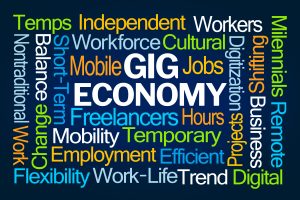
by admin | Feb 22, 2022 | Human Resources, Workplace
 Since the start of the pandemic, the gig economy has become more ubiquitous. Human Resources leaders need to understand the new kind of worker attracted to the world of gigs, and learn how to make that kind of non-traditional worker fit into their teams.
Since the start of the pandemic, the gig economy has become more ubiquitous. Human Resources leaders need to understand the new kind of worker attracted to the world of gigs, and learn how to make that kind of non-traditional worker fit into their teams.
Some mistakenly believe that the gig economy, also known as the shared economy, only refers to on-demand jobs like driving for Uber or Lyft or making Amazon deliveries. However, it is also applicable to white-collar jobs. It’s becoming a solution for employees, who need more flexibility, and employers, who need talent during a historic labor shortage. The HR Exchange Network’s State of HR Report revealed that HR leaders hold flexible work culture as a top priority, second only to employee engagement and experience. Buying into gig work might be a way to address both those priorities.
What Is the Gig Economy?
“The gig economy is a free market system in which temporary, flexible jobs are commonplace and companies bring on independent contractors and freelancers instead of full-time employees, and in many cases, for short-term engagements,” according to Embroker.
A look at the numbers demonstrates how important it is for HR leaders to pay attention and get up to speed on how this new kind of work arrangement could influence their business. By 2023, the global gig economy is expected to be a $455 billion industry, according to Harvard Business Review. Two million new workers joined the U.S. freelance workforce in 2020. In fact, one in three working Americans rely on freelancing for all or part of their income. Gallup estimates roughly 57 million Americans are gig workers, according to Forbes.
“The rapidly accelerating growth of the gig economy represents one of the most significant and all-encompassing challenges faced by Human Resources professionals,” according to SHRM. “The fundamental question is whether Human Resources can demonstrate the agility to lead the change in culture, programs, processes, and policies originally designed for work completed by full-time employees to a new era when more of the work is being completed by a talent portfolio increasingly represented by contingent workers (also referred to as gigsters, free agents, temporary help, agency workers, on-call workers, contract workers, independent contractors, or freelancers).”
Pros of the Gig Economy
Affordable Labor
A full-time employee requires a salary and benefits. You have to make hefty investments in training and career progression. Hiring an on-demand worker eliminates the need for all that. You pay them per project or on an hourly basis for as long as you need them. They usually can work remotely or only need to come into an office or place of business on a limited basis.
Specific Skills or Talents
Sometimes, you need an expert in an area for one or two projects and not on a regular basis. Being able to hire contract workers as you need them means you can look for exactly what you need at that moment. You don’t necessarily have to worry about well-rounded skills like you might with a full-time hire.
Flexibility
Freelancers and on-demand hires offer flexibility. Even if you’re renewing a contract with one of them on a regular basis, you only have to pay them for the work they actually do. You can turn to them when the work demands more help or when their particular service will enhance outcomes.
Cons of the Gig Economy
Carousel of Workers
Team dynamics can be hard to pin down when you are always working with different people. Even if you consistently work with the same freelancers, they are not bound by the same participation expectations as full-time workers. This can make it even more challenging to define a culture or help teams better collaborate.
Different Kind of Relationships
There’s more of a hierarchy when you are working with full-time employees. Managers and supervisors oversee their work and usually provide some sort of performance measurements to track their progress. With freelancers, you are their client. They are still working for you, but it changes the dynamic of the relationship.
This becomes most complicated with contingent workers, who work consistently for a company but without job security or traditional benefits. They do this for a number of reasons, including having more freedom over their schedules, being able to work for others, and being their own boss. As a result, the contract dictates their work more than the manager does. However, the manager or company could end up being a dissatisfied customer, and contingent workers can be let go at any time and you don’t have to prove they deserved to be fired.
Lack of Routine
If you’re working with a blended team – full-time employees and freelancers or contingent workers – you might have a hard time creating a solid schedule or routine for the group. Potentially you could still get the job done, but full-time employees might feel inconvenienced or maybe even a bit resentful. They have to be in one place for a certain amount of time, whereas their freelance counterparts are free to work on their own clock.
Obviously, there are pros and cons to the gig economy. But HR leaders can’t afford to ignore the fact that there is a societal shift toward this kind of workplace, where people have more freedom over their schedules, the kind of work they do, and even the relationship they have with employers. There’s still so much we have to figure out when it comes to the gig economy.
“Online gig work has grown increasingly common in recent years – and yet there’s still limited understanding of how to effectively support these non-traditional workers,” according to Harvard Business Review. “While gig workers can benefit from greater flexibility and autonomy than traditional employees, they also face unique challenges: less job security, fewer resources for career development, and often, a strong sense of alienation and difficulty finding meaning in their work.”
In fact, many reports have suggested that HR leaders in the future will provide access to resources regarding benefits like medical insurance instead of paying for it as they would for a full-time employee. Companies may begin to support co-working spaces to prevent isolation of their contingent or freelance workers. The point is that change is afoot, and HR leaders are paving the way for this new work paradigm.
By Francesca Di Meglio
Originally posted on HR Exchange Network

by admin | Jun 24, 2021 | Human Resources
 There are certain issues that have taken center stage in the collective conscious when talking about the workplace, the future of work and how the current workforce is faring under the current conditions. Naturally, as those things enter the collective conscious, researchers find themselves asking what exactly holds true and what can we learn from it?
There are certain issues that have taken center stage in the collective conscious when talking about the workplace, the future of work and how the current workforce is faring under the current conditions. Naturally, as those things enter the collective conscious, researchers find themselves asking what exactly holds true and what can we learn from it?
As usual, my inbox is full of the latest studies and surveys being conducted by HR vendors, researchers and employers of all sizes. In today’s data drop, we’re going to take a closer look at how employees view diversity and inclusion efforts, what challenges they’re facing when it comes to mental health and the impact the gig economy is having.
The D&I Appetite
At this point, there should be little doubt around the importance of D&I or DEI in your organization. It’s been well established the impact it has on the bottom line and employer brands, but if you needed more reassurance, the latest study from Boston Consulting Group should hammer it home.
The study asked questions of more than 200,000 employees across 190 countries and the results shouldn’t come as a surprise to anyone who’s been following sentiments around DEI over the last year. Results included the following:
- More than half (51%) of U.S. respondents said they would exclude a company from their job search if its values and stance on diversity and inclusion (D&I) didn’t match their own beliefs. This number was even higher among respondents 30 years and younger (56%).
- D&I became more important over the last year across all age groups globally. In the U.S., respondents 30 years and younger (72%) were most likely to agree with this statement compared to all U.S. respondents (63%) and all respondents globally (69%).
It’s a notable sentiment following the release of research by diversity platform Headstart as part of its “Discrimination in American Hiring” report. The findings show that 54% of those seeking a new job in the last two years felt they were frequently discriminated against. That number rose to 66% for Black Americans and 83% for those who identify as gender-diverse. Interestingly, however, 30% of respondents who faced recruitment discrimination would consider reapplying for the same company.
Mental Health Struggles
In June of last year, the Centers for Disease Control and Prevention (CDC) released data which showed that 40% of Americans were struggling with mental health. That number hasn’t decreased as the pandemic has continued and the months that followed included a hectic election and numerous other crises.
A more recent report from The Standard, an Oregon based insurance company, showed that 55% of workers surveyed said that a mental health issue had affected them more since the pandemic began. MetLife’s annual Employee Benefits Trends Study backs this up, with 54% saying mental health has been their biggest concern during the pandemic.
This won’t come as a surprise to HR teams that have been working toward developing mental health support tools for their workforces, but it should also be extended to talent teams as they consider their hiring processes.
Among the unemployed, one in five are or have been treated for depression in the last year. Many suffer from sleep loss and high levels of stress that can impact their ability to search and interview for a new job. Long term unemployment can lead to serious health issues such as obesity and other conditions related to stress and inactive lifestyle.
Expanding Gig Economy
Globally the gig economy has seen a boom as layoffs and needs for flexible scheduling have seen more people around the world adopt gig work than ever before. In the U.S., around 40% of Americans are currently working in gig or contract roles.
Job boards are now seeing a stark rise in contract job postings, with Resume-Library noting a 58% increase in the demand for handyman roles month over month. While many think of rideshare drivers and freelancer graphic artists when they think of gig work, the top five gig postings on the site now include the following:
- Handyman +58.3%
- Market Researcher +50%
- Packer +20.3%
- Social Media +4.5%
- Photographer +4.3%
The U.S. is currently the fastest growing freelance market in the world, experiencing a 78% growth in gig positions over the last year, with the UK following behind at 59% and Brazil at 48%.
By David Rice
Originally posted on ThinkHR

by admin | Jul 2, 2019 | Benefit Management, Human Resources
 By now you’ve heard of the term “gig economy” but you may not know what it means. Is it describing the economy of musicians as they work gigs? Does it mean something about computers and the measurement of space allotted for their programs? Does it have something to do with fishing? Well, not exactly. But, have no fear! We will break this term down into easy bites and you’ll be an expert on the gig economy in no time.
By now you’ve heard of the term “gig economy” but you may not know what it means. Is it describing the economy of musicians as they work gigs? Does it mean something about computers and the measurement of space allotted for their programs? Does it have something to do with fishing? Well, not exactly. But, have no fear! We will break this term down into easy bites and you’ll be an expert on the gig economy in no time.
What IS the Gig Economy?
The term “gig economy” refers to the new landscape of employment in the world where workers are hired for temporary, flexible jobs instead of full-time permanent positions. Think of it this way: workers in a gig economy are paid for completing a job in a predetermined timeframe—like musicians are paid for a night of music (a gig) at a venue. In a gig economy, you see that independent contractors and freelancers tend to be hired over the more traditional, full-time job seekers. Examples of jobs that thrive in this economy are technology-based positions, creative jobs, and the new tide of service-based positions in companies like Uber, Airbnb, and Instacart.
Gig Economy Numbers
Forbes magazine reports that according to the 2018 numbers from the Bureau of Labor Statistics, there are 55 million people in the US classified as gig workers. This is a huge number! In fact, that translates to more than 35% of the current US workforce. Projected to rise to 42% in 2020, over 40% of these workers are estimated to be millennials. As those numbers increase, the proportion of male to female workers shifts. Once right at 50/50, the new ratio is 60/40. This is attributed to larger numbers of women returning to school for postsecondary education. In fact, many leave the workforce completely to return to school versus taking courses and working at the same time.
Pros of Gig Economy Jobs
There are many pros to a job in this category. Job seekers who are looking for gig economy positions name flexible workplaces and flexible hours as their top priorities. The shift to remote offices as well as the freedom to work at whatever hours are most convenient definitely supports this new economy. Employees who have the discipline to manage their workflow and complete tasks on time are ones that will thrive in a gig job. The positives are not limited to just the employees, though. Employers like being able to choose new hires from a much larger pool of candidates because they are not tied down to job seekers in their immediate vicinity. Employers are also able to save money as they do not have to invest in work equipment, health benefits, or on-going training for these independent workers.
Cons of Gig Economy Jobs
The cons of gig work are some of the flip sides to the pros of gig work. These drawbacks include the absence of health benefits and 401k benefits. Freelancers have to buy their own healthcare and figure out their own savings schedule for retirement—both of which aren’t impossible, but they do take up time and tend to be at a greater expense than the benefits offered in a traditional work environment. Gig workers also face the reality of no paid sick days or vacation days. If a freelancer has the flu, he isn’t paid for the time he misses from work and his deadline isn’t adjusted in this task-based economy. On the employer side of the equation, companies report that the pool of qualified candidates for higher level management positions continues to get smaller as the trend for gig workers who freelance from job-to-job increases
The workplace continues to evolve from a traditional 9-5 workday in a traditional office environment to one that is a flexible work cycle in an ever-changing location. Employees place high priority on setting their own rhythm for work flow and prize independence. Employers are encouraged to stay in-tune with the gig economy and to seek ways to marry their company’s needs with the needs of this new workforce population. Both employer and employee can benefit from this new work landscape.

by admin | Sep 12, 2018 | Employee Benefits, Workplace
 Understandably, some employers (and employees) have mixed feelings about the gig economy. While many enjoy the freedom gained and overhead saved, others miss office camaraderie and routine. No matter your position, research shows that the trend isn’t going anywhere anytime soon. By 2021, 9.2 million Americans will work on-demand jobs, and so employers need to start asking themselves how they plan to keep employees of all stripes engaged in office work and culture.
Understandably, some employers (and employees) have mixed feelings about the gig economy. While many enjoy the freedom gained and overhead saved, others miss office camaraderie and routine. No matter your position, research shows that the trend isn’t going anywhere anytime soon. By 2021, 9.2 million Americans will work on-demand jobs, and so employers need to start asking themselves how they plan to keep employees of all stripes engaged in office work and culture.
As HR Technologist cautions, employee engagement goes both ways.While employers should be concerned about the reliability and loyalty of their freelance pool, they must also maintain strong relationships with their current full-time employees. Best practices for addressing this include providing similar perks to all workers, using in-depth onboarding services and training, and maintaining meticulously open lines of communication.
It is also important to remember that integration like this can’t happen overnight. Building a strong and diverse team, whether fully remote or mixed, takes time. Many companies are engaging “future ready” practices, so that hybrid workforces can be available whenever a particular company is ready to consider open options. Such practices are rooted primarily in savvy digital platforms, allowing for collaboration and innovation, as well as clear conversations about benefits and salaries. Not only do such techniques strengthen the current team, but they also position organizations as solid competitors for rising digital talent. Finally, remember that talent management isn’t merely an agenda item. It’s also a driving tool for strategic decisions about innovation, growth, and performance ability.
While there is no one established way forward, it’s clear that employers who are cognizant of the growing gig economy trend are able to both deepen and strengthen their current talent pool while looking toward the future.
by Bill Olson
Originally posted on UBAbenefits.com

 Since the start of the pandemic, the gig economy has become more ubiquitous. Human Resources leaders need to understand the new kind of worker attracted to the world of gigs, and learn how to make that kind of non-traditional worker fit into their teams.
Since the start of the pandemic, the gig economy has become more ubiquitous. Human Resources leaders need to understand the new kind of worker attracted to the world of gigs, and learn how to make that kind of non-traditional worker fit into their teams.


